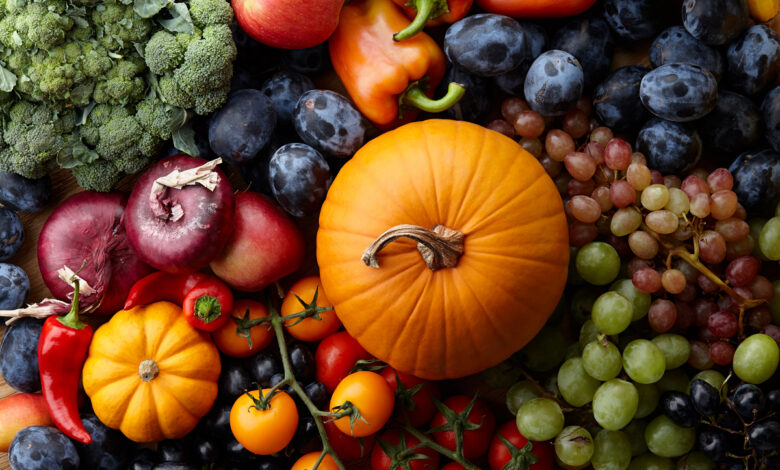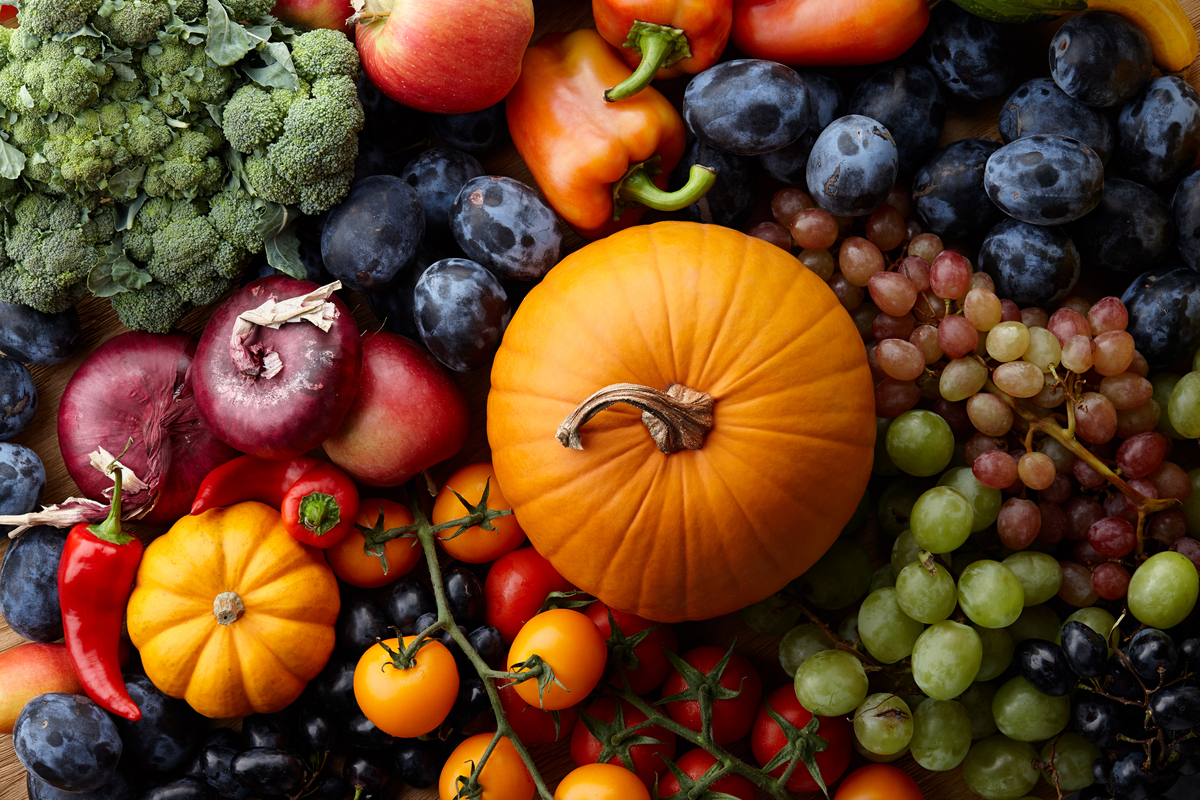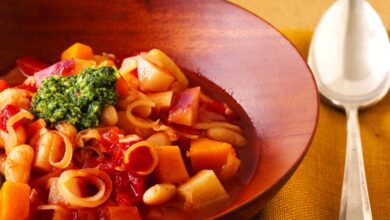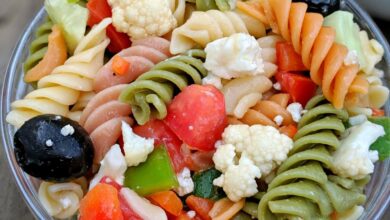
Seasonal Fruits and Vegetables to Eat This Fall
As seasonal fruits and vegetables to eat this fall take center stage, the crisp air and changing leaves signal a shift in our culinary landscape. This is the time to embrace the bounty of nature’s harvest, with an abundance of flavors that tantalize the palate and nourish the body.
From juicy apples and plump pears to hearty squashes and vibrant greens, fall offers a cornucopia of fresh produce bursting with vitamins, minerals, and antioxidants. This season, let’s celebrate the unique flavors of fall and enjoy the benefits of eating seasonally.
Beyond the deliciousness, choosing seasonal fruits and vegetables supports local farmers, reduces our environmental impact, and ensures we’re getting the freshest, most nutrient-rich produce available. So, let’s delve into the world of fall fruits and vegetables, discover their unique qualities, and explore ways to incorporate them into our everyday meals.
Introduction to Fall Fruits and Vegetables
Fall is a time of change, not just in the weather but also in the bounty of nature’s harvest. As summer fades, the landscape transforms into a vibrant palette of reds, oranges, and yellows, mirroring the abundance of seasonal fruits and vegetables that grace our tables.
Fall is the perfect time to indulge in seasonal fruits and vegetables like crisp apples, juicy pomegranates, and hearty pumpkins. But before you dive into your fall harvest, why not start your day with a boost of energy? Try incorporating a quick yoga routine like the stretches energize morning 5 pose yoga fix to awaken your body and mind.
This will set you up for a day filled with healthy choices, including those delicious fall fruits and vegetables.
These fall offerings are not only delicious but also packed with essential nutrients, making them a vital part of a healthy diet.
Nutritional Benefits of Fall Produce
Fall fruits and vegetables are bursting with vitamins, minerals, and antioxidants that support our overall well-being. For example, pumpkins, a quintessential fall staple, are rich in vitamin A, which is crucial for healthy vision, skin, and immune function. Apples, another fall favorite, are a good source of fiber, which aids digestion and helps regulate blood sugar levels.
Eating seasonally ensures that we consume fruits and vegetables at their peak ripeness, maximizing their flavor and nutritional value.
Supporting Local Farmers
Beyond their nutritional benefits, fall fruits and vegetables also offer a unique opportunity to connect with our local communities and support sustainable agriculture. By purchasing produce from local farmers’ markets or farm stands, we contribute to the livelihoods of our neighbors and encourage responsible farming practices.
This direct connection to the source of our food allows us to appreciate the hard work and dedication that goes into bringing these delicious and nutritious foods to our tables.
Fall Fruits
Fall is a time of abundance when it comes to fruits. The cooler temperatures and shorter days bring a burst of flavors and colors to our plates. From crisp apples to juicy pomegranates, fall fruits offer a delightful mix of sweetness, tartness, and unique textures.
Fall is the perfect time to load up on delicious seasonal fruits and vegetables like apples, pears, and butternut squash. These nutrient-rich foods can be incorporated into healthy meals and snacks, and if you’re looking for some extra motivation to eat well, check out your 7 day guide to forming better habits for weight loss.
This guide can help you create sustainable changes that will support your weight loss goals and make it easier to enjoy the bounty of fall flavors!
Let’s dive into the world of fall fruits and explore their nutritional benefits and culinary possibilities.
Nutritional Profiles of Fall Fruits
Fall fruits are packed with essential vitamins, minerals, and antioxidants that contribute to overall health and well-being. The table below highlights the nutritional profile of some popular fall fruits:| Fruit | Vitamins | Minerals | Antioxidants ||—|—|—|—|| Apples | Vitamin C, Vitamin K, Potassium | Potassium, Phosphorus | Quercetin, Catechin || Pears | Vitamin C, Vitamin K, Copper | Potassium, Phosphorus | Flavonoids, Phenolic acids || Pomegranates | Vitamin C, Vitamin K, Potassium | Potassium, Phosphorus | Punicalagins, Ellagic acid || Persimmons | Vitamin A, Vitamin C, Potassium | Potassium, Phosphorus | Carotenoids, Polyphenols |
Unique Flavor Profiles of Fall Fruits
Each fall fruit possesses a distinct flavor profile that makes it unique.* Apples:Apples are known for their crisp texture and sweet-tart flavor. The variety of apple cultivars offers a wide range of flavor profiles, from the sweet and juicy Honeycrisp to the tart and tangy Granny Smith.
Pears Pears have a delicate, sweet flavor with a hint of tartness. They offer a smooth, buttery texture that melts in your mouth. The Anjou pear is known for its sweet flavor, while the Bosc pear is known for its more intense, nutty flavor.
Pomegranates Pomegranates are bursting with a sweet and tangy flavor. Their seeds are packed with antioxidants and offer a delightful crunch.
Persimmons Persimmons have a unique flavor profile that combines sweetness with a subtle hint of astringency. The Fuyu persimmon is known for its soft, sweet flavor, while the Hachiya persimmon is known for its firmer texture and more intense flavor.
Incorporating Fall Fruits into Recipes
Fall fruits can be incorporated into a variety of dishes, from sweet desserts to savory salads.* Desserts:Apples and pears are perfect for pies, crumbles, and tarts. Pomegranates can be used as a topping for yogurt parfaits or added to fruit salads.
Persimmons can be enjoyed as a simple snack or used in baked goods.
Salads Apples and pears can be added to salads for a sweet and crunchy element. Pomegranates can be used to add a burst of flavor and color to salads.
Beverages Apples and pears can be used to make delicious juices and smoothies. Pomegranates can be used to make refreshing juices or added to sparkling water for a unique flavor twist.
Fall Vegetables

Fall is a time of abundance when the earth yields a bounty of flavorful vegetables, each offering a unique taste and texture. From hearty root vegetables to vibrant leafy greens, the harvest season brings a kaleidoscope of colors and flavors to our plates.
Let’s explore the diverse world of fall vegetables, uncovering their culinary potential and discovering ways to savor their goodness.
Fall Vegetables: A Harvest of Flavor
Fall vegetables are a culinary treasure trove, offering a wide array of flavors and textures that can transform any meal. These vegetables are a vital part of a healthy diet, providing essential vitamins, minerals, and antioxidants.
- Root Vegetables:Root vegetables are a staple of fall cuisine. Their rich flavors and firm textures lend themselves to a variety of cooking methods. Some popular root vegetables include:
- Potatoes:Potatoes are a versatile vegetable that can be roasted, mashed, fried, or baked.
They are a good source of vitamin C and potassium.
- Sweet Potatoes:Sweet potatoes are a delicious and nutritious root vegetable with a naturally sweet flavor. They are a good source of vitamin A and fiber.
- Carrots:Carrots are a crunchy and flavorful root vegetable that can be enjoyed raw, roasted, or steamed.
They are a good source of vitamin A and beta-carotene.
- Beets:Beets are a vibrant root vegetable with a sweet and earthy flavor. They can be roasted, pickled, or used in salads. Beets are a good source of folate and fiber.
- Turnips:Turnips are a versatile root vegetable with a slightly sweet and peppery flavor. They can be roasted, mashed, or added to soups and stews. Turnips are a good source of vitamin C and potassium.
- Potatoes:Potatoes are a versatile vegetable that can be roasted, mashed, fried, or baked.
- Leafy Greens:Leafy greens are a healthy and flavorful addition to any fall meal. They are packed with vitamins, minerals, and antioxidants. Some popular leafy greens include:
- Kale:Kale is a hearty leafy green with a slightly bitter flavor. It can be roasted, sautéed, or added to smoothies.
Fall is the perfect time to embrace seasonal flavors and get back on track with healthy eating. From crisp apples and juicy pears to hearty pumpkins and vibrant squashes, there’s a bounty of delicious produce to enjoy. If you’re looking for ways to rediscover lost healthy habits, incorporating these seasonal fruits and vegetables into your diet is a great place to start.
Check out ways to rediscover lost healthy habits for more tips on making healthier choices. And don’t forget to try a pumpkin spice latte with a side of roasted butternut squash – it’s the perfect fall treat!
Kale is a good source of vitamin K, vitamin A, and calcium.
- Spinach:Spinach is a versatile leafy green with a mild flavor. It can be steamed, sautéed, or added to salads. Spinach is a good source of vitamin K, folate, and iron.
- Collard Greens:Collard greens are a hearty leafy green with a slightly bitter flavor. They can be boiled, sautéed, or added to soups and stews. Collard greens are a good source of vitamin K, vitamin A, and calcium.
- Kale:Kale is a hearty leafy green with a slightly bitter flavor. It can be roasted, sautéed, or added to smoothies.
- Brassicas:Brassicas are a family of vegetables that includes broccoli, cauliflower, Brussels sprouts, and cabbage. They are packed with nutrients and have a slightly bitter flavor.
- Broccoli:Broccoli is a versatile vegetable that can be roasted, steamed, or sautéed. It is a good source of vitamin C, vitamin K, and fiber.
- Cauliflower:Cauliflower is a versatile vegetable that can be roasted, steamed, or mashed. It is a good source of vitamin C, vitamin K, and fiber.
- Brussels Sprouts:Brussels sprouts are a small, cabbage-like vegetable that can be roasted, steamed, or sautéed. They are a good source of vitamin C, vitamin K, and fiber.
- Cabbage:Cabbage is a versatile vegetable that can be braised, sautéed, or used in salads. It is a good source of vitamin C, vitamin K, and fiber.
- Squash:Squash is a versatile vegetable that comes in a variety of shapes, sizes, and colors. Some popular fall squash include:
- Butternut Squash:Butternut squash is a sweet and nutty squash that can be roasted, pureed, or used in soups. It is a good source of vitamin A and fiber.
- Acorn Squash:Acorn squash is a sweet and nutty squash that can be roasted, stuffed, or used in soups. It is a good source of vitamin A and fiber.
- Pumpkin:Pumpkin is a versatile squash that can be roasted, pureed, or used in pies and soups.
It is a good source of vitamin A and fiber.
Cooking Methods for Fall Vegetables
Fall vegetables lend themselves to a variety of cooking methods, each enhancing their unique flavors and textures.
- Roasting:Roasting brings out the natural sweetness of vegetables, creating a caramelized and flavorful dish. Root vegetables, squash, and brassicas are particularly well-suited for roasting.
- Roasted Root Vegetables:Preheat oven to 400 degrees Fahrenheit. Toss root vegetables (such as potatoes, carrots, and beets) with olive oil, salt, and pepper.
Spread vegetables in a single layer on a baking sheet and roast for 30-40 minutes, or until tender and slightly caramelized.
- Roasted Squash:Preheat oven to 400 degrees Fahrenheit. Cut squash in half lengthwise and remove seeds. Drizzle with olive oil, salt, and pepper.
Place cut-side down on a baking sheet and roast for 45-60 minutes, or until tender.
- Roasted Brassicas:Preheat oven to 400 degrees Fahrenheit. Cut broccoli, cauliflower, or Brussels sprouts into bite-sized pieces. Toss with olive oil, salt, and pepper.
Spread vegetables in a single layer on a baking sheet and roast for 20-25 minutes, or until tender.
- Roasted Root Vegetables:Preheat oven to 400 degrees Fahrenheit. Toss root vegetables (such as potatoes, carrots, and beets) with olive oil, salt, and pepper.
- Grilling:Grilling adds a smoky flavor to vegetables, creating a unique and delicious dish. Leafy greens, squash, and root vegetables can be grilled.
- Grilled Leafy Greens:Marinate leafy greens (such as kale or spinach) in olive oil, lemon juice, and garlic. Grill for 2-3 minutes per side, or until tender.
- Grilled Squash:Cut squash into thick slices. Brush with olive oil, salt, and pepper. Grill for 5-7 minutes per side, or until tender.
- Grilled Root Vegetables:Cut root vegetables (such as potatoes, carrots, and beets) into thick slices. Brush with olive oil, salt, and pepper.
Grill for 5-7 minutes per side, or until tender.
- Steaming:Steaming preserves the nutrients and vibrant colors of vegetables, creating a light and flavorful dish. Leafy greens, brassicas, and root vegetables can be steamed.
- Steamed Leafy Greens:Place leafy greens (such as kale or spinach) in a steamer basket. Steam for 2-3 minutes, or until tender.
- Steamed Brassicas:Cut broccoli, cauliflower, or Brussels sprouts into bite-sized pieces. Steam for 5-7 minutes, or until tender.
- Steamed Root Vegetables:Cut root vegetables (such as potatoes, carrots, and beets) into bite-sized pieces. Steam for 10-15 minutes, or until tender.
- Sautéing:Sautéing adds a quick and flavorful touch to vegetables, creating a delicious side dish or ingredient for main courses. Leafy greens, brassicas, and root vegetables can be sautéed.
- Sautéed Leafy Greens:Heat olive oil in a skillet over medium heat. Add leafy greens (such as kale or spinach) and sauté for 2-3 minutes, or until wilted.
- Sautéed Brassicas:Cut broccoli, cauliflower, or Brussels sprouts into bite-sized pieces. Heat olive oil in a skillet over medium heat. Add vegetables and sauté for 5-7 minutes, or until tender.
- Sautéed Root Vegetables:Cut root vegetables (such as potatoes, carrots, and beets) into bite-sized pieces.
Heat olive oil in a skillet over medium heat. Add vegetables and sauté for 10-15 minutes, or until tender.
Fall Vegetable Recipes
Fall vegetables are incredibly versatile, starring in main courses, side dishes, and soups. Here are some recipe ideas to inspire your culinary creativity:
- Main Courses:
- Roasted Butternut Squash and Sausage Pasta:This dish features roasted butternut squash, Italian sausage, and pasta tossed in a creamy sauce.
- Braised Short Ribs with Root Vegetables:Tender short ribs are braised with root vegetables (such as carrots, potatoes, and turnips) in a rich and flavorful sauce.
- Grilled Salmon with Roasted Brussels Sprouts:Grilled salmon is paired with roasted Brussels sprouts for a healthy and delicious meal.
- Side Dishes:
- Mashed Sweet Potatoes with Maple Syrup:Creamy mashed sweet potatoes are enhanced with a touch of maple syrup for a sweet and savory side dish.
- Roasted Broccoli with Garlic and Parmesan:Roasted broccoli is tossed with garlic and Parmesan cheese for a flavorful and satisfying side dish.
- Sautéed Spinach with Lemon and Garlic:Sautéed spinach is brightened with lemon juice and garlic for a simple and healthy side dish.
- Soups:
- Creamy Pumpkin Soup:This classic soup features roasted pumpkin, cream, and spices for a comforting and flavorful meal.
- Carrot Ginger Soup:This vibrant soup features carrots, ginger, and coconut milk for a healthy and flavorful meal.
- Hearty Vegetable Stew:A hearty vegetable stew is packed with fall vegetables (such as potatoes, carrots, and turnips), beans, and herbs for a satisfying and comforting meal.
Storing and Preserving Fall Vegetables
To enjoy the bounty of fall vegetables throughout the season, proper storage and preservation techniques are essential.
- Storing:
- Root Vegetables:Store root vegetables in a cool, dark, and dry place. Avoid storing them in the refrigerator, as this can cause them to become soft and mushy.
- Leafy Greens:Store leafy greens in a plastic bag in the refrigerator.
Wash and dry them thoroughly before storing.
- Squash:Store squash in a cool, dry place. Avoid storing them in the refrigerator, as this can cause them to become soft and mushy.
- Preserving:
- Freezing:Many fall vegetables can be frozen for later use. Blanch vegetables before freezing to preserve their color, texture, and flavor.
- Canning:Canning is a great way to preserve fall vegetables for extended storage. Follow proper canning guidelines to ensure food safety.
- Pickling:Pickling is a great way to preserve fall vegetables and add a tangy flavor. Follow proper pickling guidelines to ensure food safety.
Fall Produce in Your Kitchen
Fall is the perfect time to embrace the bounty of the season and fill your kitchen with delicious and nutritious fruits and vegetables. From crisp apples to hearty squashes, the fall harvest offers a wide array of flavors and textures to enhance your meals and snacks.
Incorporating Fall Produce into Daily Meals and Snacks
Fall produce can easily be incorporated into your daily meals and snacks. Here are some tips:
- Start your day with a bowl of oatmeal topped with chopped apples, cinnamon, and a drizzle of honey.
- Add sliced pears or cranberries to your yogurt or granola for a sweet and refreshing snack.
- Roast butternut squash or sweet potatoes and serve them as a side dish with your dinner.
- Make a hearty salad with kale, pomegranate seeds, and toasted pecans for a satisfying lunch.
Creative Ideas for Fall Produce
Fall fruits and vegetables lend themselves to a variety of creative uses in the kitchen. Here are some ideas for incorporating them into smoothies, salads, and baked goods:
- Blend apples, pears, and cinnamon into a warming smoothie for a comforting breakfast or snack.
- Toss roasted butternut squash, kale, and cranberries with a maple vinaigrette for a vibrant fall salad.
- Bake a delicious apple crisp with a crumble topping for a classic fall dessert.
- Add chopped apples or pears to your pancake batter for a touch of sweetness and fall flavor.
Incorporating Fall Flavors into Seasonal Recipes
Fall flavors can be easily incorporated into a wide range of seasonal recipes. Here are some ideas:
- Add pumpkin puree to your favorite muffin recipe for a warm and comforting treat.
- Use apple cider in your soup or stew for a touch of sweetness and fall flavor.
- Roast Brussels sprouts with maple syrup and pecans for a delicious and satisfying side dish.
- Make a comforting butternut squash soup with a dollop of Greek yogurt and a sprinkle of toasted pumpkin seeds.
The Benefits of Seasonal Eating
Eating seasonally offers numerous advantages, not only for our health but also for the environment. By aligning our diets with the natural rhythms of the earth, we can support sustainable farming practices, enjoy the peak flavor and nutritional value of produce, and contribute to a healthier planet.
Environmental Benefits of Locally Grown Produce
Choosing locally grown produce has a significant impact on reducing our carbon footprint. When fruits and vegetables travel long distances from farms to our tables, they contribute to greenhouse gas emissions from transportation. By opting for produce grown closer to home, we minimize the environmental impact associated with long-distance shipping.
Nutritional Advantages of Seasonal Produce, Seasonal fruits and vegetables to eat this fall
Fruits and vegetables harvested at their peak ripeness contain the highest levels of vitamins, minerals, and antioxidants. When produce is grown out of season, it often relies on artificial fertilizers and pesticides, which can diminish its nutritional value. Seasonal produce, on the other hand, thrives naturally in its optimal growing conditions, resulting in a higher concentration of essential nutrients.
Taste and Quality of Seasonal Produce
Seasonal fruits and vegetables are renowned for their superior flavor and quality. Produce grown in its natural season benefits from the optimal sunlight, temperature, and rainfall, resulting in a richer, more complex taste. In contrast, produce grown out of season may lack the depth of flavor and texture characteristic of seasonal varieties.
Resources for Finding Local Farmers Markets and Farm-to-Table Restaurants
Connecting with local farmers and supporting farm-to-table restaurants is a rewarding way to embrace seasonal eating. Many online resources and mobile apps can help you find farmers markets and restaurants in your area that prioritize local and seasonal produce.
Last Recap: Seasonal Fruits And Vegetables To Eat This Fall
As the days grow shorter and the air turns cooler, let’s embrace the flavors of fall and enjoy the abundance of seasonal fruits and vegetables. From the sweet crunch of an apple to the earthy richness of a butternut squash, each bite offers a taste of the season and a reminder of nature’s bounty.
So, let’s celebrate the harvest, support our local farmers, and savor the deliciousness of fall produce in all its glory.






